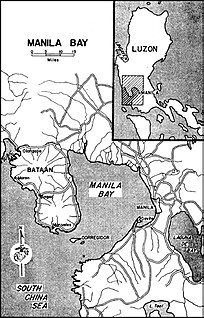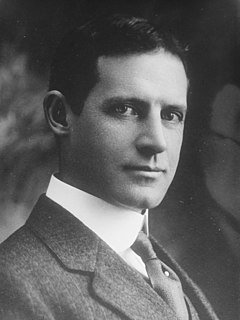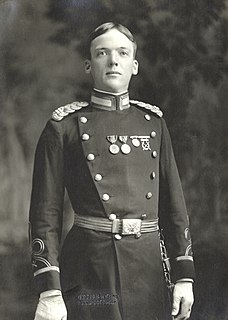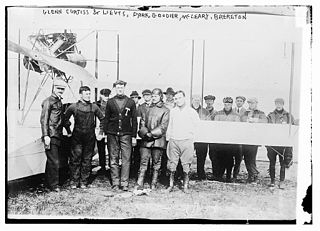
The Harbor Defenses of Manila and Subic Bays were a United States Army Coast Artillery Corps harbor defense command, part of the Philippine Department of the United States Army from circa 1910 through early World War II. The command primarily consisted of four forts on islands at the entrance to Manila Bay and one fort on an island in Subic Bay.

Henry Harley Arnold was an American general officer holding the ranks of General of the Army and later, General of the Air Force. Arnold was an aviation pioneer, Chief of the Air Corps (1938–1941), commanding general of the United States Army Air Forces, the only United States Air Force general to hold five-star rank, and the only officer to hold a five-star rank in two different U.S. military services. Arnold was also the founder of Project RAND, which evolved into one of the world's largest non-profit global policy think tanks, the RAND Corporation, and one of the founders of Pan American World Airways.

Raynal Cawthorne Bolling was the first high-ranking officer of the United States Army to be killed in combat in World War I. A corporate lawyer by vocation, he became an early Army aviator and the organizer of both of the first units in what ultimately became the Air National Guard and the Air Force Reserve Command.

The Cessna L-19/O-1 Bird Dog is a liaison and observation aircraft. It was the first all-metal fixed-wing aircraft ordered for and by the United States Army following the Army Air Forces' separation from it in 1947. The Bird Dog had a lengthy career in the U.S. military, as well as in other countries.

Joseph Oswald Mauborgne co-invented the one-time pad with Gilbert Vernam of Bell Labs. In 1914 he published the first recorded solution of the Playfair cipher. Mauborgne became a Major General in the United States Army, and from October 1937 to his retirement in 1941 was the Army's 12th Chief Signal Officer, in command of the Signal Corps.

The Philippines campaign, also known as the Battle of the Philippines or the Fall of the Philippines, was from December 8, 1941, to May 8, 1942, the invasion of the Philippines by the Empire of Japan and the defense of the islands by United States and the Philippine Armies during World War II.

The Battle of Corregidor, fought on May 5–6, 1942, was the culmination of the Japanese campaign for the conquest of the Commonwealth of the Philippines during World War II.

Benjamin Delahauf Foulois was a United States Army general who learned to fly the first military planes purchased from the Wright brothers. He became the first military aviator as an airship pilot, and achieved numerous other military aviation "firsts". He led strategic development of the Air Force in the United States.

The Aeronautical Division, Signal Corps (1907–1914) was the first heavier-than-air military aviation organization in history and the progenitor of the United States Air Force. A component of the U.S. Army Signal Corps, the Aeronautical Division procured the first powered military aircraft in 1909, created schools to train its aviators, and initiated a rating system for pilot qualifications. It organized and deployed the first permanent American aviation unit, the 1st Aero Squadron, in 1913. The Aeronautical Division trained 51 officers and 2 enlisted men as pilots, and incurred 13 fatalities in air crashes. During this period, the Aeronautical Division had 29 factory-built aircraft in its inventory, built a 30th from spare parts, and leased a civilian airplane for a short period in 1911.

The Aviation Section, Signal Corps, was the aerial warfare service of the United States from 1914 to 1918, and a direct statutory ancestor of the United States Air Force. It absorbed and replaced the Aeronautical Division, Signal Corps, and conducted the activities of Army aviation until its statutory responsibilities were suspended by President Woodrow Wilson in 1918. The Aviation Section organized the first squadrons of the aviation arm and conducted the first military operations by United States aviation on foreign soil.

The Burgess Company was a U.S. airplane manufacturer between 1910 and 1918.

Frank Purdy Lahm was an American aviation pioneer, the "nation's first military aviator", and a general officer in the United States Army Air Corps and Army Air Forces.

Herbert Arthur "Bert" Dargue was a career officer in the United States Army, reaching the rank of major general in the Army Air Forces. He was a pioneer military aviator and one of the first ten recipients of the Distinguished Flying Cross.

Paul Ward Beck was an officer in the United States Army, an aviation pioneer, and one of the first military pilots. Although a career Infantry officer, Beck twice was part of the first aviation services of the U.S. Army, as de facto head of the flying section of the Aeronautical Division, U.S. Signal Corps in 1911 and as a senior officer of the Air Service in 1920–1922. He is generally credited as being the first military officer to advocate an air force for the United States separate from the control of other branches of the Army.

Charles Evans Kilbourne Jr. was the first American to earn the United States' three highest military decorations. As an officer in the United States Army he received the Medal of Honor for his actions during the Philippine–American War and he served as a general officer during World War I. After World War I, he served as the Superintendent of the Virginia Military Institute, succeeding General John A. Lejeune, and had a post-military career as a distinguished writer.

The Martin S was a two-seat observation seaplane produced by the Glenn L. Martin Company in the United States in 1915. Designed along the same general lines as the preceding Model T, it was a largely conventional two-bay biplane with unstaggered wings of equal span. The fuselage was not directly attached to the lower wings, but was carried on struts in the interplane gap. The undercarriage consisted of a single large pontoon below the fuselage and outrigger floats near the wingtips. The Model S was 23-year-old Donald Douglas' first and only design for the Martin company, and it set three world altitude records and a flight duration record that stood for three years.

The Dunne D.8 of 1912 was a tailless swept wing biplane, designed by J. W. Dunne to have inherent stability. One example was supplied to RAE Farnborough. License-built Burgess-Dunne models were used by the US Signal Corps and United States Navy and the short-lived Canadian Aviation Corps. It was the latter's first and only warplane.

Lewis Edward Goodier Jr. was a pioneer aviator and, as such, a member of the Early Birds of Aviation. He served in the United States Army and later the United States Air Force, and rose to the rank of lieutenant colonel.

Townsend Foster Dodd was the first commissioned US Army aviator. As a University of Illinois graduate with a Bachelor of Science in electrical engineering, he joined the Coast Artillery Corps and shortly thereafter became an aviator in the US Army Air Service. Dodd sat on many boards of review during the service's infancy and was one of the members who condemned pusher planes in favor of tractors. He served with General John Pershing on the Mexican Border where he set records for endurance flying. During World War I he was first assigned as the aviation officer of the American Expeditionary Force in 1917. He was later replaced by Colonel Billy Mitchell and was reassigned to the Bolling Mission.

Byron Quinby Jones was a pioneer aviator and an officer in the United States Army. Jones began and ended his career as a cavalry officer, but for a quarter century between 1914 and 1939, he was an aviator in the various organizations that were the Army's air arm. He appeared to be on track in the 1930s to becoming one of the senior commanders of the Air Corps, but his views on the role of airpower diverged from those of his Air Corps peers and he returned to the Army's ground forces at the beginning of World War II.




















